China and Brazil shed large portions of their holdings, but the top financial centers loaded up.
By Wolf Richter for WOLF STREET.
The total amount of Treasury securities outstanding has reached $33.89 trillion and is going to hit $34 trillion shortly. Every one of these securities must be sold to someone, and foreign holders play a huge but declining role:
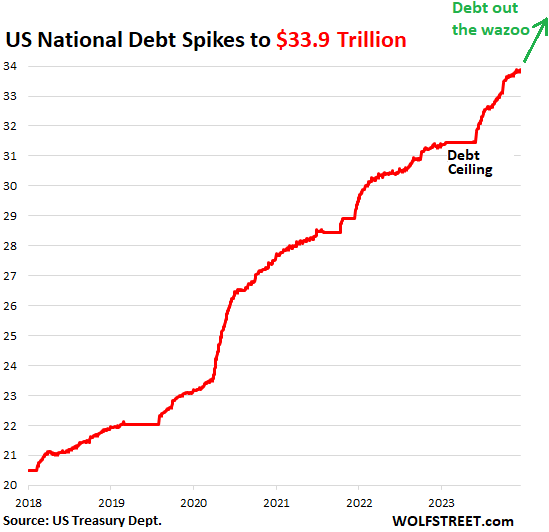
Foreign holders in aggregate have kept their holdings of US Treasury securities roughly stable for the past two years. In October, their holdings dipped to $7.56 trillion, up about 6% from a year ago, but the same as in June 2021, according to TIC data from the Treasury Department released Tuesday afternoon (red line in the chart below)
- The top six financial centers (London, Belgium, Luxembourg, Switzerland, Cayman Islands, Ireland) decreased their holdings to $2.22 trillion, down from the record in August (blue line):
- Japan, #1 single US creditor, increased its holdings in October to $1.10 trillion (green), but that’s down from the $1.3 trillion range in 2021.
- China and Hong Kong combined further reduced their holdings to $969 billion (purple).
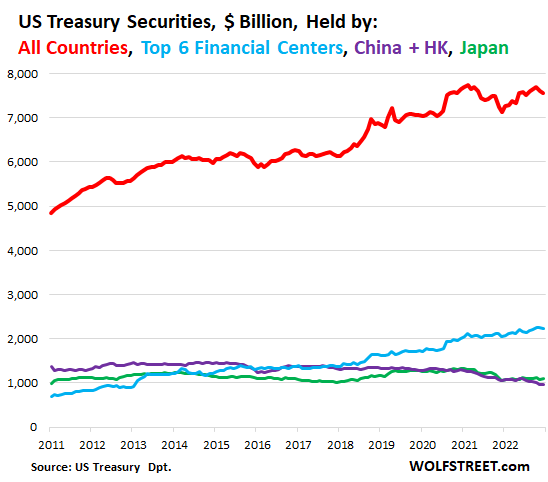
Foreign holders have not kept up buying the incredibly ballooning US government debt, and as a result, the share of their holdings has plunged to a share of 22.4%, from the range of around 33% in 2015. In other words, the US debt financing has become less dependent on foreign holders:
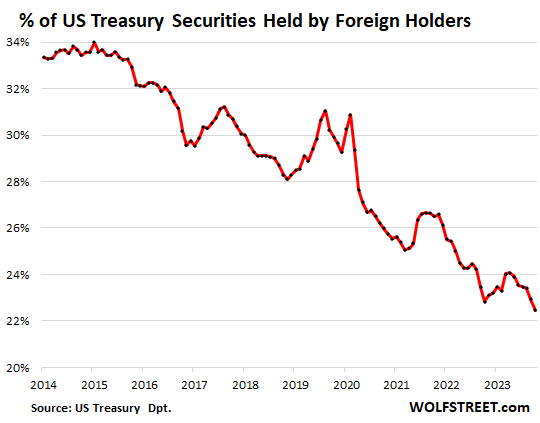
The six largest financial centers – the UK (actually the City of London), Belgium, Luxembourg, Switzerland, Cayman Islands, and Ireland – reduced their holdings a little in October, after the record in August, to $2.22 trillion
These countries specialize in handling and often obscuring the financial holdings of global companies, individuals, and governments. Ireland is a favorite for US companies to store their profits:
- UK: $693 billion
- Luxembourg: $345 billion
- Cayman Islands: $324 billion
- Ireland: $299 billion
- Belgium (home of Euroclear): $285 billion
- Switzerland: $276 billion.
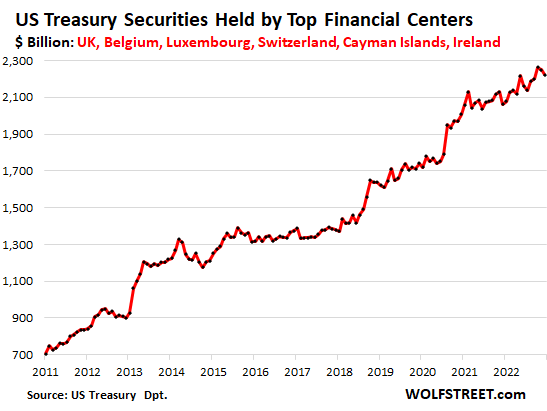
Japan’s holdings, after dropping sharply last year, have zigzagged up again this year, and in October ticked up to $1.1 trillion, up by 3.2% from a year ago.
Late last year, the Ministry of Finance sold some US-dollar assets, presumably Treasury securities, or let T-bills mature without replacement, to get the dollar-cash, and then blew $68 billion in dollar-cash to buy yen in the foreign exchange market to prop up the yen after it had plunged to ¥150 to the dollar by October 2022.
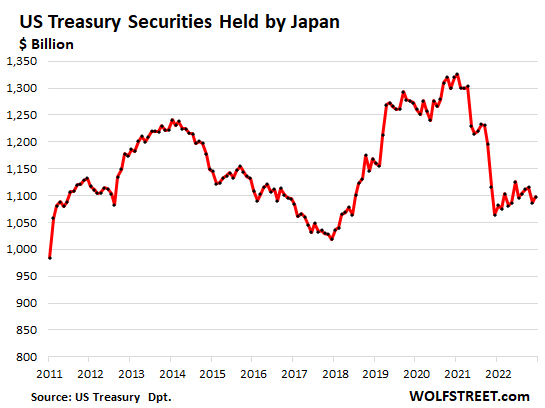
China and Hong Kong combined have been unloading Treasuries for years. In October, their combined holdings of Treasuries fell to $969 billion, the lowest in the data going back to 2011 (red in the chart below), down by 8.9% from a year ago.
During the capital-flight panic in 2016, China sold Treasury securities to prop up the RMB. It then increased its holdings again. But since Covid, the combined holdings have plunged by 29%.
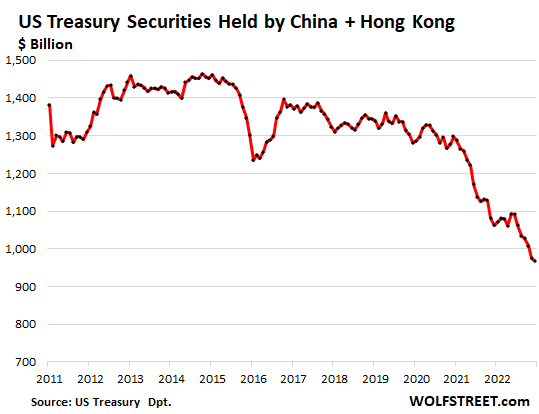
Other top foreign holders:
Canada’s holdings ticked up to $281 billion, up by 29% year-over-year, after having hit a record in August:
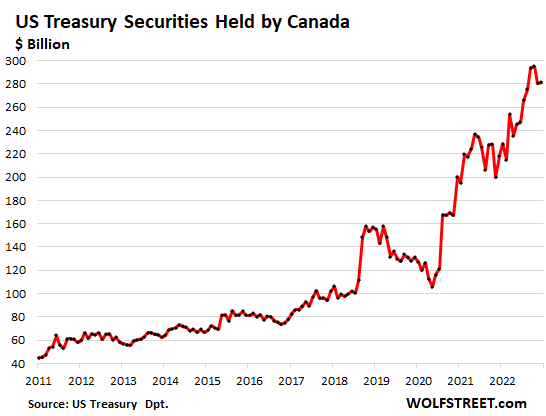
Taiwan’s holdings fell to $231 billion, but were up 7.8% year-over-year. They’d hit a record in December 2021, and holdings have gyrated up and down since then:
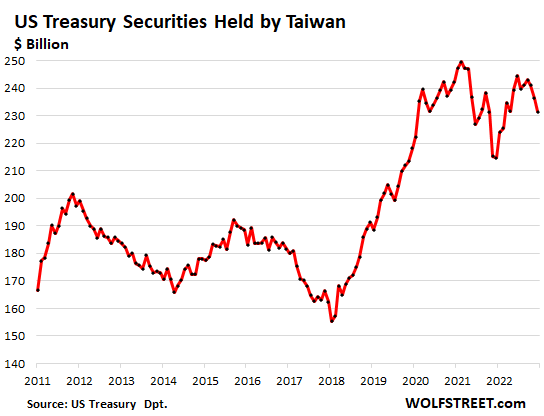
India’s holdings fell to $222 billion, first reached in October 2020, having declined every month since the peak in April, but were still up 4.2% year-over-year:
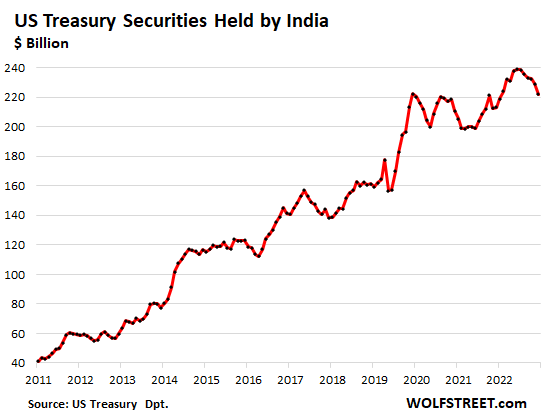
Brazil’s holdings fell to $219 billion, and were roughly flat year-over-year, after having spiraled down by about one-third since the peak in 2018.
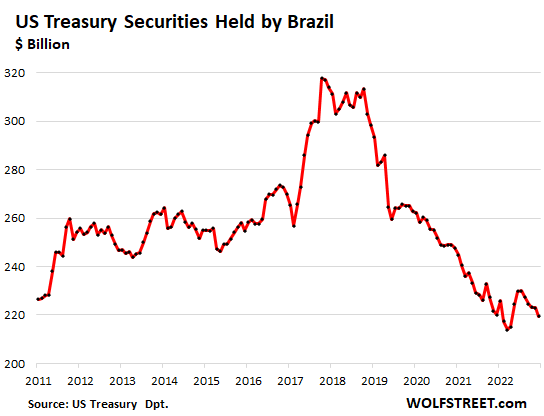
Enjoy reading WOLF STREET and want to support it? You can donate. I appreciate it immensely. Click on the mug to find out how:
![]()


BTFP spiking as I bail out more banks with your money!
My Chinese friend printed trillions to build houses for 3 billion people to create fake asset as big as US real estate.
much bigger than US real estate
10 year is now below 3.9%. I wonder if anyone would think that the 5.5% – 3.9% gap of 1.6% is just noise.
Looking at administration approval ratings gives some insights on consumers real mood.
I can do 10 month CD at 5.12%
still waffling
But all the lagging indicators look great! /s
It will take many many years to meaningfully reduce the amount of US debt sold to foreign investors. Meanwhile watch the increase in US denominated debt issued by foreign governments to finance their increasing deficits.
Also the IMF, world bank etc debts incurred….all in greenbacks.
Which country controls IMF etc?
Hi rodolfo could you help me here…
Why would foreign governments issue dollar denominated debt to finance deficits?
Usually countries with trade deficits need dollar debt…which are often caused by energy subsidy or high capex. The trend generally is for countries to fully pass through energy prices. Maybe there are companies that are going through big capex cycles.
Aman
“Why would foreign governments issue dollar denominated debt to finance deficits?
B/c no one would buy their debt instruments denominated in their local currencies. US $ is better currency risk. Going on for decades.
Depth of Market, Atman. You can’t just park $10-$20 billion in a secondary currency.
IMF and World Fund are controlled directly and indirectly mainly by USA, in appointing senior officials.
Not as big as US since the Chinese government isn’t bailing out its real estate, much to the disappointment of foreign speculators.
They loved treasuries when rates were zero. Now that it’s higher, they’re dumping?
Who says bond holders are the *smart* money? I never thought this held water.
When the $ becomes strong,they need $s to prevent their Currencies weakening.
Perhaps they’ve decided to pull the plug on the dollar. We would never have had zero rates for a decade without the rest of the world going along with it. Remember in 08 when Putin was talking about a replacement for the dollar being needed? Perhaps they’re done talking. Maybe 2020 was another financial crisis, but the rest of the world told us they weren’t going to go along anymore except Europe. Ever consider Europe pushes EV and all the green crap cause they have no hydrocarbons?
Keep reading CNN and Wall Street Journal, i’m sure they’ll inform you two days after all your investments have gone to zero ;)
It’s hard to take Russia seriously when we have three separate public companies with market capitalizations that are larger than this “world power’s” GDP.
Phony valuation based on collectivist madness/scifi fantasy vs a vast chunk of earth overflowing with much needed natural resources.
But I bet you thought NFTs were a good investment too, right?
I replied to you, but i suppose it was offensive in some manner. Essentially everything in our society is fraud, so who are we to say who has the stronger economy? Sanctions were supposed to destroy Russia, they seem to be doing just fine. Perhaps even getting stronger.
Wolf-
On 4th chart, and bulleted list above, is UK about $700 billion? It seems to have fallen through the cracks, or I’m missing something obvious…
Thanks for all of your insights.
Also, you must get more sleep!
Yes, there was a big crack and the entire UK fell right through it. $693 billion. Thanks!
Wolf, you have the best editors anywhere; polite abd even worried about your health. Well done,sir. And thank you.
Thanks for a great piece Wolf. You have answered a question I have had for some time and that is why does the rest of the world keep buying the US ballooning, dare I say, unsustainable debt? I now see that but for Japan that they are wizening up.
I struggle to comprehend what a billion is, let alone Elon Musks worth of 254 billion give or take. The concept of 34 trillion is so huge it is beyond comprehension. You could sell Alaska and perhaps get 5 trillion which would barely make a dent. On the positive side they need to keep attracting buyers so perhaps that will push up yields.
Hmmm. Much more supply and less demand. Not the greatest set up for US Treasury bond prices.
Meanwhile, not much value (yield premium over inflation)
and Powell has sent the message he has pivoted to prioritizing growth over inflation.
I think we’re in a secular bear market for bonds.
re: “I think we’re in a secular bear market for bonds.”
A reversal of Yellen’s operation twist.
At what point does debt to gdp reflect in a country’s stated interest rates?
I see where japans debt to gdp is 3 times.
But no meaningful interest rate jump.
The USA debt to gdp is ~1.2 times.
Small interest rate jump.
And Argentina debt to gdp is ~1.5 times
And 100% annnual interest rate jump.
So since Japan can have 3 times debt to gdp, and no interest rate jump, why doesn’t Argentina follow that model too?
How much debt to gdp can Japan have before interest rates reflect its huge national debt load? 5 times, 10 times?
Help me out here.
Because if a country’s national debt has nothing to do with its interest rate, then that country should simply borrow away without a care in the world, like Japan is able to do, and still does while running a 1% interest rate.
Inflation
Tend to think like you…but I don’t think (not 100% sure) that Japan has seen bad inflation since 1990.
Off hand guess…if the *G* has to create artificial demand for engorged ntl debt, then inflation is likely (since G can only utilize printing or taxation in order to finance phony debt demand).
But in Japan, savers have apparently been beaten down into compliance…they will buy their G’s debt at 0% rather than invest overseas. And Japanese savers still save like hell. So Japanese rates kept very low by domestic private saving (versus G money print).
Argentina is…the opposite. Savings class knows its G are economic gangsters, so they send their savings out of the country (capital flight). But Argentina’s G still controls printing press…so it prints and prints and prints to fund its transfer of wealth from private to (sorta, very sorta) public sector. Result…very high perpetual inflation.
The attitude of domestic savers seems to be key as to whether or not engorged ntl debt leads to consumer inflation.
I think the size of the economy matter. As Japan is the 3rd largest economy, they can print whatever amount they wish to. So do America! Keep printing until the day rest of the world realize why they want the paper freshly out of others Centre Bank while exchanging it with tangible assets? That’s the time of reckoning and you would see the domino collapse of these highly indebted nation.
As the main stream economists like to predict those nonsense of Debt to GDP is mainly use to justify the collapse of third world countries economies when they learnt from these OECD countries to print their monies.
You spelled wreconing wrong=sarc
simonyoosen
“until the day rest of the world realize why they want the paper freshly out of others Centre Bank while exchanging it with tangible assets?’
The US credit/fixed income markets are the largest in the world, comprising 40.0% of the $130 trillion securities outstanding across the globe, or $52 trillion (as of FY22)
The other currencies are worse in terms of risk. The US currency is backed by a democratically run govt, strong military and property rights. So it is TINA until better replacement comes along!?
Japan is a creditor nation. They also have spent years suppressing their rates into negative territory.
My question is does this drop in foreign ownership of treasuries portend an erosion of confidence in the US economy and the treasury debt that props it up?
With the US running deficits 36% over revenue (FY ’24: $1.7T/$4.7T), the chances of the US running a ground due to a recession goes down dramatically. Tax receipts dropped last year due to a slowing economy / financial markets in the form of lower capital gains taxes. That may be turning around, since we’re up $108B in revenue for the first two months of the year. However, the deficit increased $48B over the same period.
Right now, the labor market remains buoyant and will likely remain that way through the first half of ’24. Construction is NOT anywhere near slowing down. However, the markets seem to be getting way ahead of when rate cuts are likely to happen, but that’s not to be surprised given the current macro environment. Inflation may have well be at a lower resistance. The question is does & how much will it rise in ’24?
There are definitely cracks like consumer debt, core PCE @ 4% and how much lowered mortgage rates will stimulate housing demand in the spring. With treasury yields moderating & the BTFP shooting up, one would imagine that, for now, the banking crisis crack is shrinking.
Personally, I’m not a fan of aggregate GDP comparisons. Trying to figure out the magical dept : GDP ratio is a wild goose chase. Late ’25 will be interesting, because that’s when the Trump tax cuts expire.
My guess is that there is simply not enough capital in the world to keep financing the US ballooning debt. The only nation that keeps printing is Japan. But a reverse trend is likely, that countries will start selling the US debt to prop up their currencies, budgets, current accounts, etc. Also it makes sense to sell now, as foreign holders of the US assets see the end of the strong dollar era.
There will always be demand for US Treasuries. Yield solves that problem. That’s what yield is for. If 10-year Treasuries are hard to sell at 4% yield, then try 4.1%, and suddenly there’s more demand, and then when that demand is sated, and you need to sell more, you may have to go to 4.2% yield, etc.
The question is this: at what yield do the interest payments become burdensome and drag down the economy?
Countries have different personalities, just like some people. Some are thrifty and prudent, planning for the future. Some are spendthrifts, depending on God to take care of “manana”. The first one can live well with much higher debt.
Your explanation implies that the “thrifty and prudent” take on more debt than those who are not. Doesn’t this statement strike you as odd? It certainly doesn’t square with the usual narratives associated with debtors in my experience.
I think the point is that more prudent people, even if the country is running higher debts, won’t drive prices up by spending ever dollar being handed to them.
For one thing,Japan holds a huge amount of US Treasuries while Argentina does not.
It litteraly depends on perception and what people are willing to lend. People perceive Japan as stable and trustable, and so they buy its debt (especially themselves.) The ratio of debt to gdp that will start to break that will depend entirely of the attitudes of such lenders and will be a much higher ratio of debt to gdp for Argentina which has lost trust by defaulting a large number of times over the last 100 years.
Its all perception and attitude in the worlds largest confidence game. There are no hard laws of mathmatics here — if Japan’s image of being a trustable debtee is truly unshakable then they can barrow every last bit of money in existance without an issue.
Wolf,
Does the US hold any foreign national debt?
Dave
The Fed and the US government don’t hold foreign sovereign debt. But US pension funds, bond funds, insurance companies, etc. hold lots of foreign sovereign debt, they’re big buyers of this stuff, including from emerging markets.
Having the #1 global reserve currency means that the government doesn’t need foreign exchange reserves.
Is there data on foreign private companies’/ funds’ holdings of US treasuries?
Sorry, but doesn’t the US Treasury hold some?
https://home.treasury.gov/data/us-international-reserve-position/12012023
Or is this something else?
Look at the amounts: $6.6 billion in euros, $233 million in yen, LOL?
The bigger stuff on this list (but still small) are the IMF Special Drawing Right (SDR), gold certificates, etc.
When you say “financial center”, what does that mean exactly? Are these banks, what is the actual entity that is buying? Where are the dollars coming from. I presume this would be dollar reserves on the balance sheet of these entities? Is this correct?
It depends. And there is a great variety of options, much of it legal under US law, some illegal. A US company, such as Apple, can have billions of dollars in an account registered at an address in Ireland, and those billions are invested in US Treasuries, among other US assets, and those assets can be managed from an office in the US. So they’re assets of a US company, managed in the US, but they’re listed in Ireland because the account holding those Treasuries is in Ireland.
I bring up this example because it was revealed by a US Senate inquiry a few years ago.
Wolf why has no paper us currency been printed since 2017
LOL. Where did you get THAT gem?
Since 2017, $830 billion in “paper currency” (officially Federal Reserve Notes, or Currency in Circulation) has been printed. It rose from $1.50 trillion at the beginning of 2017 to $2.33 trillion now.
Scroll down to the section “Currency in Circulation…”
https://wolfstreet.com/2023/09/16/feds-balance-sheet-liabilities-rrps-plunge-reserves-rise-after-bank-panic-currency-in-circulation-dips-after-pandemic-spike-tga-gets-refilled/
Find me some dollar bills in any denomination ,with a date after 2017
OK, I get it. You’re trafficking in ignorant conspiracy bullshit. Just because you don’t know, or because some idiot-moron blogger or YouTuber out there doesn’t know, and you believed their shit, doesn’t mean it’s true.
1. Dollar bills are printed in “series.”
2. The currently printed series are the “Series 2017”. Before then, there was the “Series 2013.”
3. In addition, $1-bills and $5-bills are currently printed in the “Series 2021.”
4. The Bureau of Engraving and Printing, which prints the dollar bills, releases monthly production reports. So every idiot-moron could in theory go look it up instead of making up bullshit and spreading it via my site – including the idiot-moron blogger/YouTuber you got this braindead shit from.
5. Here are the Bureau of Engraving and Printing’s monthly reports on what it actually printed that month, from Sep 2023 all the way back to Oct 2002.
https://www.bep.gov/currency/production-figures/monthly-production-reports
6. And here is the last available report on what the BEP printed in Sep 2023, by series and serial numbers and amounts.
https://www.bep.gov/sites/default/files/documents/12-Sep%20FY23%20End%20of%20the%20Month%20Report%2010.26.23.pdf
Now you owe me a $100 donation for me having to manually remove toxic materials from your brain. Here is how:
https://wolfstreet.com/how-to-donate-to-wolf-street/
Many United States Notes, Silver and Gold certificates and other “horse blanket” large banknotes of a hundred -plus years ago were also issued in a series, and can only be dated as to actual year of issue by the signatures of the government officials on the obverse
Wolf, I really appreciate replies like this. While any idiot could look up this data from the Bureau of Engraving and Printing, it honestly never occurred to me that I haven’t seen any post-2017 bills. Even though I always notice Mnuchin’s signature and smile to remember back when US political drama felt more funny than consequential.
LOL that there’s a conspiracy theory around this.
WB,
A financial center is a concentration of money/lenders that facilitate worldwide trade. Traditionally, the largest were New York, London, Japan, Frankfurt, and Hong Kong. I wouldn’t consider Hong Kong as important anymore, but there are other smaller centers too.
Quite true. As a longtime lover of Hong Kong, it is saddening to see how the country’s miserable autocratic leadership have decided to trash it. An astute leadership would have tried to make the rest of China more like Hong Kong but these losers? They know nothing.
Changes in China’s US Dollar holdings has little to do with its favorable or unfavorable view of US Debt Instruments. Instead it’s a sign of China’s failing economy as it transitions from free-market economic principles (i.e., capitalism) back to totalitarian state control (i.e., communism). As the demand for yuan collapses, China must sell its dollar denominated assets to buy yuan, or to buy food or oil on the international market.
Or the Chinese do not want their US dollars seized as happened to Russia. With the US running a trade deficit some must increase their holdings of US debt, at the moment it look like China do not want to.
This may be the reason China has shown restraint as regards Chinese Taipei.
Some people are pushing for these Russian funds to be given to Ukraine. That would surely make other countries think twice.
They certainly don’t want their dollars seized, but as others have said in various threads here, TINA to the dollar. There is no other huge transparent liquid market, certainly not one backed by a huge functional country.
If “fear of US financial power” was enough for China to move away from the dollar, they’d have done it decades ago.
Lol. The definition of communism is not totalitarian state control. Plus it uses a form of state capitalism with a private industry. Based on your definition we might as well call the US a totalitarian representative democracy controlled by Wall Street and political servants.
Don’t push the narrative politicians want and create another cold war. They don’t serve anyone’s interests but those of the few.
“The definition of communism is not totalitarian state control.”
Leninism would indicate in practice it might as well be.
Certainly, there are aspects of democracies that are more perception than reality, but the distinction still has a meaningful difference.
Ok, spout Marx or Mao. Don’t care. I will be in Maui and maybe the Big Island for a month, recharging my batteries for a great 2024. You can eat your righteous, revolutionary gruel all day and be happy.
Merry Christmas. God Bless America.
Maybe once you’re in Maui you can consider the utter injustice that was cast on the native people of the Hawaiian islands. But doubt you will since you’re a fairly simple minded consumer who does as Wall Street says
Maui is a long way to go to find a compatible charger
If I’m not mistaken, Russia held up to $150B during 2011 to 2012 and during the following years consistently sold them off. Now it holds virtually zero. That’s one buyer that’s probably not coming back. China may be following the same playbook.
How are these values determined? Value at maturity, or current market value?
Face value, just like the total US debt — that $33.9 trillion is face value, the total amount owed.
All bonds have CUSIP numbers and are registered with the Treasury Dept. because it has to send the coupon interest payments to the holders and the redemption amount when the bonds mature.
Another great article Wolf! Forcasting out (if the charts maintain their trajectory) the likely assumption is the National Debt reaching 40 trillion (another 6t) by the end of 2025. Meanwhile the second chart of top foreign holders, by the end of 2025 could potentially take up another 1 trillion. It’s hard to fathom who will be buying potentially the 5 trillion of debt coming in the next 2 years?
The FED will have to monetize a lot of this forecasted Treasury issuance. Interest rates will remain higher for longer solely because of the upcoming fiscal deficits.
Such deficit projections will transform the FED’s sterilization efforts. The FED will have to reimpose reserve requirements (which should never have been eliminated). The FED will have to go from an ample reserves’ regime to a scarce reserves’ regime. It will have to resort to raising reserve ratios to accommodate surging fiscal demands.
Monetary policy should delimit all legal reserves to balances in their District Reserve bank, as originally defined in 1917 (IBDDs, like the ECB), and have uniform reserve ratios, for all deposits, in all banks, irrespective of size (something Nobel Laureate Dr. Milton Friedman advocated, December 16, 1959).
I.e., the 1959 change permitting the use of vault cash (liquidity reserves) to satisfy reserve requirements, was a mistake. I.e., monetarism has never been tried. I.e., contrary to Friedman and Volcker, legal reserves were never a tax!
spenser-
Could you elaborate on why the Fed will “have to monetize?” If rates stay higher for longer, don’t higher rates (perhaps quite a bit higher) at some level draw in new domestic or foreign demand for treasuries? It seems these are two distinct methods of handling Treasury funding needs. Perhaps your suggesting both will be necessary?
I’m not proposing an opposing theory, just looking for clarity on the subject…
Thanks
Oops…. “You’re” not your…
The O/N RRP funding rate is an interest rate floor. That floor’s support will end when the O/N RRP is emptied.
“Reverse repo transactions temporarily reduce the supply of reserve balances in the banking system.”
https://www.newyorkfed.org/markets/domestic-market-operations/monetary-policy-implementation/repo-reverse-repo-agreements
But like Wolf says, higher rates will solve the funding issue.
The US just mints up excess debt and allows this debt to roll off the balance sheet. So foreign buyers are no longer important. $33 Trillion US debt and moving upward to $34 Trillion US Debt is more concerning than foreign buys. Since the current administration politics is centered toward isolationism certain foreign investors would unwind their US debts. US policy with China would invent a situation where US attempts to no longer purchase or allow export of certain goods.
Wolf:
Would Canada’s Primary Dealers (Royal and TD) at the Fed, with their requirement to buy U.S. Debt as Market Makers, cause the increase in Canada’s holdings of U.S. Debt? I don’t see any other compelling reason why Canada, with it’s relatively comparative conservative Monetary Policy, to be interested in buying proportionally larger amounts of U.S. Debt.
It’s not the Canadian banks that are primary dealers, but their US subsidiaries. European and Japanese banks also have subsidiaries in the US that are primary dealers. When they buy Treasuries, it’s no different than other US primary dealers buying Treasuries. After they buy them, they usually sell them to the market, that’s what their function is, and those Treasuries end up somewhere else.
I cannot fathom why Canada is buying up 39% more US Treasuries?
Canadians diversifying into USD and earning 4% to 5.5% on their USD holdings? That’s higher than the yields on Canadian Treasury bills (3-month yield is about 4.97%) and on Government of Canada bonds (10-year yield of around 3.1%).
Canada,
They are investing the money I spend on Canadian websites, some of my favorites.
US Tbills paying higher than Canadian right now. Not by much though so currently I hold short term Canadian due to them being tax free in my TFSA, but anyone maxed out or playing with large amounts will probably go for the extra ~ half percent.
The Era of Money.
There was the Era of Meat.
There was the Era of Grain.
There was the Era of Metals.
We are in the Era of Money.
Era of Meat. (hunter-gatherer, nomadic) (local)
Era of Grain. (agrarian, settled location civilizations) (regional) (ex. ancient egyptians, babylonians, indus, valley, meso-america, etc.)
Era of Metals. (empires and industrialization, coinage) (continental) (persians, greeks, romans, chinese, portuguese, spanish, british, french, american, etc.)
Era of Money. (fiat, pervasive relativistic assignment of value of all things through numbers, financialization) (global) (secret societies, hidden alliances, rule by deception)
oh, how about this also
Era of Meat – Rule by bodily force
Era of Grain – Rule by bodily work
Era of Metals – Rule by mental innovation
Era of Money – Rule by mental manipulation
Sorry. Maybe this isn’t the place for drafting a anthropology article.
Well, all of the eras of “Rule” involve one form of compulsion or other — either via corvee labour (often accompanied by some outright slavery) or a tax obligation denominated in the meat, grain, metal or money (fiat). That’s the common thread.
hmmm……..so the logic is then that people today are generally compelled by money compared to those other temporal things.
BRW/eg – …I guess the question might become does one believe more strongly in the primacy of ‘money’, or the finity of human-sustaining planetary resources in the face of the current human population’s increasing vortex of demand upon them, and apparent lack of serious interest in maintaining/renewing what is left? (…a nuanced query and YOLO, right?).
may we all find a better day.
I believe that the US will shift away from building with lumber as our forests shrink and the quality of wood continues to decrease. The alternatives to wood are very energy intensive to produce so the alternative to building with wood is air………..home-less-ness.
Era of metals…no Brit uses that…Britland was coal, USA is coal and oil and we are still in the era of cheap coal for most of the world.
In other words, we are in the era of cheap energy and will be in this until we collapse…and we will never be in the era of electricity, that is an anti-physics con.(you can’t make many things out of electricity, certainly not your phone or computer that you type words on wolfstreet lol)
OK — but what does this MEAN? I see the aggregates and their trends but I am at a loss to assign them meaning.
Good point. There is no meaning, which is the point right? It’s transcendental knowledge now.
Could it be that another Black Swan event may occur to cause foreign buyers to stop buying Treasuries to the extent that they have in past years? If so, that could negate any Fed easing of interest rates next year, and cause interest rates to rise on their own without Fed action, right in the middle of a recession.
Swamp Creature
Study all the previous ‘Black Swans’ BEAR mkts, crashes based on any event – geopolitical, economic or whatever.
Where did the investors deposited their cash after the SELL events? The US Credit/fixed income mkt – Treasury, bills, notes and Bonds, largest in the world. 52+ Trillions
True but what if this time the US government credit market is itself the Black Swan? Usually it’s a safe haven but what if it becomes the exact opposite – a black hole where nothing can escape?
Other way around. A black swan event would cause a rush *into* treasuries rather than out of.
Treasuries are a safe haven asset, and the Fed’s FIMA repo facility has done a good job keeping up foreign demand for them.
Isn’t this good news? That means interest payments will be paid within the nation. Please advise.
Well, yes, but this will be done by taxing everyone, and giving the money to rich people. Most people will say this is not a good thing.
April 2023 – Bloomberg interview with Sam Zell on the debt.
Bloomberg: At what point does this become not a problem, but a crisis for the United States?
Zell: When people don’t want to buy our debt. When, faced with the prospect of losing the US dollar as an international currency, and if we lose the dollar as a reserve currency, we’re looking at a 20-25% reduction in our standard of living.
—–
Not completely coherent, but I did file away that video. The first step mentioned is people not buying our debt. Myself, I think that is if and when Yield Curve Control/QE comes back. Sammy is gone now, but we’ll see if he got the call right. Personally, I think so long as market interest rates exist, the debt will be sold. But, trajectory of the deficits indicates things are unsustainable.
Wolf,
With regards to the conversation we were having a few days: Is homeless worse now in San Fran then 20 years ago?
https://www.wsj.com/us-news/record-homeless-united-states-2023-ef86f904
Pretty grim. Those national homeless counts are always grim.
Booming economy baby! Nobody can afford anything except for the favored 20%!
This theme of most Americans being poor is getting stupid.
The homeless are less than 1% of the population. Homeless includes people who are couch surfing and living in vans or sleeping in shelters. The people you see sleeping on the streets are only part of them.
Then there are about 20% who are poor.
The top 50% of households earn $75,000 or more (that’s the “real” median income in 2022, per Census). They can afford all kinds of stuff. The bottom 50% earn less than $75,000. Many of them earn $73,000 or whatever.
what can i say, you can lead the horse to water, but you can’t force it to drink. I understand why you hold your viewpoints. You’re vested in this tragedy we call modern america. You’ve already stated you don’t really rub elbows with “common” people. So why would you see what i see? Anyways, happy holidays.
Yeah, Mr House I am also puzzled by America’s profligate disregard for the well-being of its most precious resource — its citizenry.
$75,000 is poverty in the city you live in Wolf
Matthew Scott,
Would fee like it, probably. But the median household income here in San Francisco is not $75,000. It is $136,000.
In my former hometown Tulsa, the median household income is $56,600.
The median household income I cited of $75,000 is the for the US overall.
Thank you, Wolf, for a great review. I was really surprised be the drop in the foreign holdings.
1) China barter and trade in Yuan. Foreign debt/ Total $34T debt is down.
2) Demand for US LNG and US dollars might rise after the Hootie event.
3) Lower US10Y makes the banks healthier. “Held to maturity” will flip to green. When the 10Y was 4.999% the banks moved in. The spread between US 10Y and Japan 10Y was over 4%. Currently it’s : 3.88 – 0.59 = 3.3%.
4) The innovator co cannibalized US Steel (X) for decades. After the 25% tariff X ceo modernized old plants piling up debt at zero rates. When rates
took off X ceo lost his guts. He sold X to Nippon steel for $14.1B. Senators Casey and Fetterman will fight it. They might force the banks to kick the can down at lower rates.
China/HK, what are they doing with their dollars?
Wolf mentions that Japan cashed out treasuries to prop up their currency. Can we say with any certainty/reliably where China is deploying their dollars? The trade balance is smaller this year, but still large. Taken along with the persistent reduction in treasuries makes me wonder where it’s all going?
Currency support? Paying down dollar-debt in soft economies? Building hoards of gold and industrial commodities? Diversifying into other nations debt/currency? All of the above? Quick Google search reveals lots of anecdotes, but nothing that feels at all definitive. Is this information even available?
It has been reported (Bloomberg?) a while back (a year ago?) that China was switching its holdings from US Treasury securities to other US government-related securities, such a agency securities or securities issued by the FHLB, that generate a slightly higher yield, so that China may not actually be getting out of USD paper. I have never been able to find any actual data to support this, but it would make sense.
I think that China is also structuring some international lending of its US dollars with the repayments required to be in renminbi/yuan instead. Perhaps this is one mechanism by which it is reducing its holdings of $USD?
If so an interesting and probably smart move. Lend in Renminbi/Yuan and pay out in US dollars. Debtors may be locked in to trade with China or at least in Yuan. That have to trade in Yuan may erode the position of the US dollar and swift system
Japan supports the US government and gets the Us military as protection. Not a bad deal
Falling interest rates are often the harbinger of recession……
Why do foreign entities buy Treasuries?
I would think that it is not as an investment or income, but somehow related to trade and parking of reserves.
What would cause them to purchase/hold relatively more or less?
I know there is talk of de-dollarization and risk of theft, but is that what’s going on here?